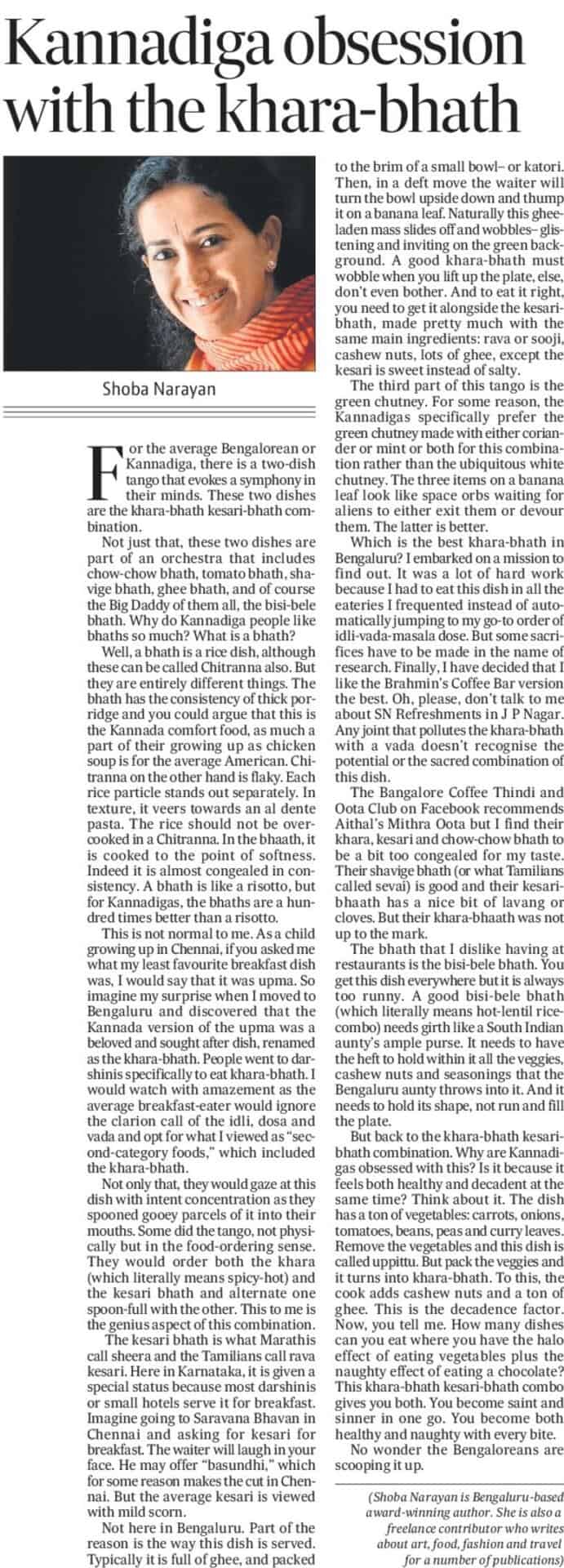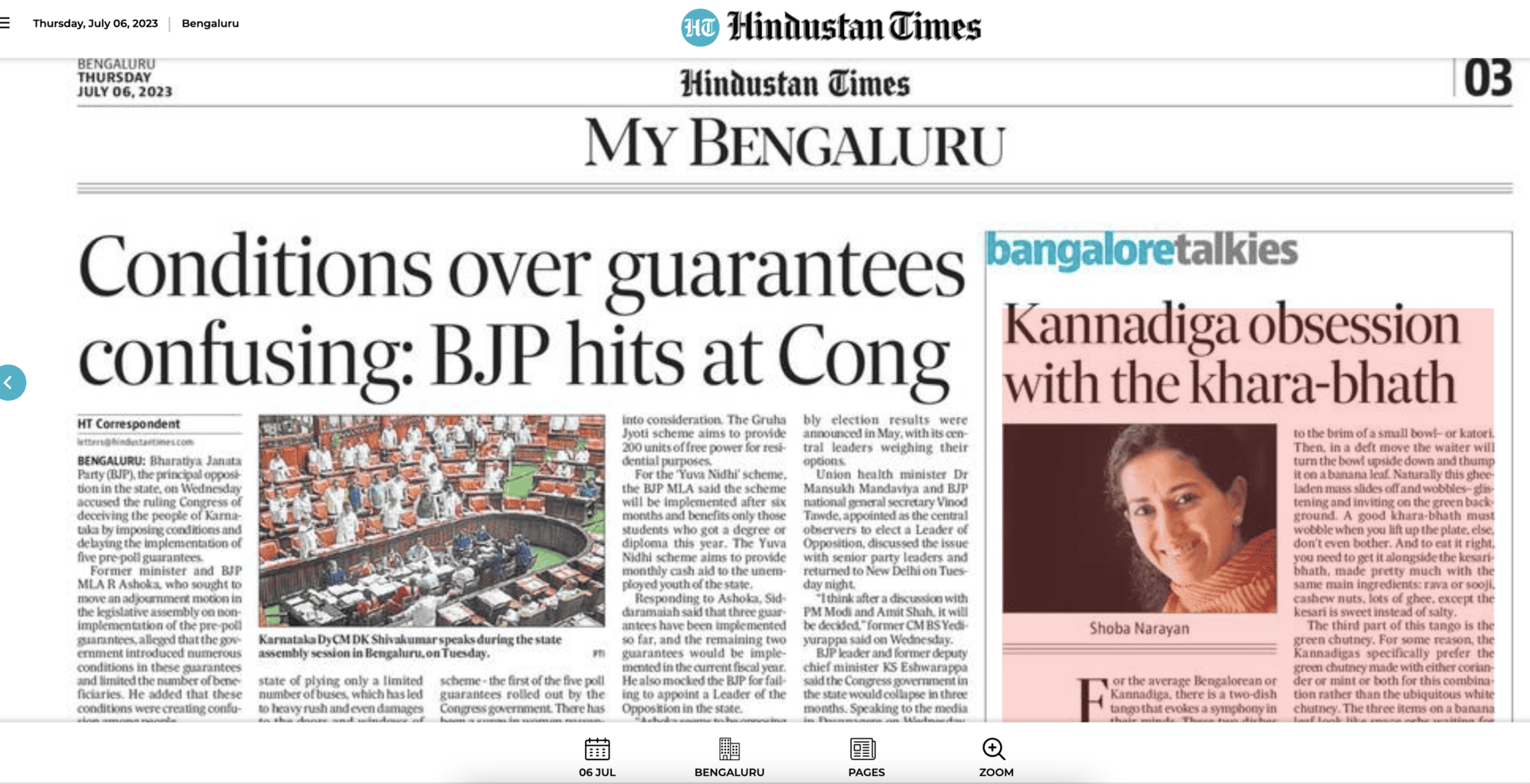For the average Bangalorean or Kannadiga, there is a two-dish tango that evokes a symphony in their minds. These two dishes are the khara-bhaath kesari-bhaath combination.
Not just that, these two dishes are part of an orchestra that includes chow-chow bhaath, tomato bhaath, shevige bhaath, ghee bhaath, and of course the Big Daddy of them all, the bisi-bele bhaath. Why do Kannadiga people like bhaaths so much? What is a bhaath?

Well, a bhaath is a rice dish, although these can be called Chitranna also. But they are entirely different things. The bhaath has the consistency of thick porridge and you could argue that this is the Kannada comfort food, as much a part of their growing up as chicken soup is for the average American. Chitranna on the other hand is flaky. Each rice particle stands out separately. In texture, it veers towards an al dente pasta. The rice should not be overcooked in a Chitranna. In the bhaath, it is cooked to the point of softness. Indeed it is almost congealed in consistency. A bhaath is like a risotto, but for Kannadigas, the bhaaths are a hundred times better than a risotto.
This is not normal to me. As a child growing up in Chennai, if you asked me what my least favourite breakfast dish was, I would say that it was upma. So imagine my surprise when I moved to Bangalore and discovered that the kannada version of the upma was a beloved and sought after dish, renamed as the khara-bhaath. People went to darshinis specifically to eat khara-bhaath. I would watch with amazement as the average breakfast-eater would ignore the clarion call of the idli, dosa and vada and opt for what I viewed as “second-category foods,” which included the khara-bhaath.
Not only that, they would gaze at this dish with intent concentration as they spooned gooey parcels of it into their mouths. Some did the tango, not physically but in the food-ordering sense. They would order both the khara (which literally means spicy-hot) and the kesari bhaath and alternate one spoon-full with the other. This to me is the genius aspect of this combination. The kesari bhaath is what Marathis call sheera and the Tamilians call rava kesari. Here in Karnataka, it is given a special status because most darshinis or small hotels serve it for breakfast. Imagine going to Saravana Bhavan in Chennai and asking for kesari for breakfast. The waiter will laugh in your face. He may offer “basundhi,” which for some reason makes the cut in Chennai. But the average kesari is viewed with mild scorn.
Not here in Bangalore. Part of the reason is the way this dish is served. Typically it is full of ghee, and packed to the brim of a small bowl– or katori. Then, in a deft move the waiter will turn the bowl upside down and thump it on a banana leaf. Naturally this ghee-laden mass slides off and wobbles– glistening and inviting on the green background. A good khara-bhaath must wobble when you lift up the plate, else, don’t even bother. And to eat it right, you need to get it alongside the kesari-bhaath, made pretty much with the same main ingredients: rava or sooji, cashew nuts, lots of ghee, except the kesari is sweet instead of salty.
The third part of this tango is the green chutney. For some reason, the kannadigas specifically prefer the green chutney made with either coriander or mint or both for this combination rather than the ubiquitous white chutney. The three items on a banana leaf look like space orbs waiting for aliens to either exit them or devour them. The latter is better.
Which is the best khara-bhaath in Bangalore? I embarked on a mission to find out. It was a lot of hard work because I had to eat this dish in all the eateries I frequented instead of automatically jumping to my go-to order of idli-vada-masala dose. But some sacrifices have to be made in the name of research. Finally, I have decided that I like the Brahmin’s Coffee Bar version the best. Oh, please, don’t talk to me about SN Refreshments in J. P. Nagar. Any joint that pollutes the khara-bhaath with a vada doesn’t recognise the potential or the sacred combination of this dish.
The Bangalore Coffee Thindi and Oota Club on Facebook recommends Aithal’s Mithra Oota but I find their khara, kesari and chow-chow bhaath to be a bit too congealed for my taste. Their shevige bhaath (or what Tamilians called sevai) is good and their kesari-bhaath has a nice bit of lavang or cloves. But their khara-bhaath was not up to the mark.
The bhaath that I dislike having at restaurants is the bisi-bele bhaath. You get this dish everywhere but it is always too runny. A good bisi-bele bhaath (which literally means hot-lentil rice-combo) needs girth like a South Indian Mami’s ample purse. It need to have the heft to hold within it all the veggies, cashewnuts and seasonings that the Bangalore Mami throws into it. And it needs to hold its shape, not run and fill the plate.
But back to the khara-bhaath kesari-bhaath combination. Why are kannadigas obsessed with this? Is it because it feels both healthy and decadent at the same time? Think about it. The dish has a ton of vegetables: carrots, onions, tomatoes, beans, peas and curry leaves. Remove the vegetables and this dish is called uppittu. But pack the veggies and it turns into khara-bhaath. To this, the cook adds cashewnuts and a ton of ghee. This is the decadence factor. Now, you tell me. How many dishes can you eat where you have the halo-effect of eating vegetables plus the naughty-effect of eating a chocolate? This khara-bhaath kesari-bhaath combo gives you both. You become saint and sinner in one go. You become both healthy and naughty with every bite.





Leave A Comment